The two cars with "The Milwaukee Road," no herald, and "Route of the Hiawathas" and "Route of the Electrified Olympian" were the as-built 1939 paint schemes. The yellow striped ones with SEL and DF markings for load-restraint equipment were converted and painted in the early 1960's. The scheme with the Milwaukee Road herald was used from the late 1950's onward. The last two paint schemes on Weaver's list, with the CMStP&P herald (one with and one without the Hiawatha logo) were in fact applied to a small number of 50' cars in the 1940's; no 40' cars are known to have been painted this way but Weaver decided to go ahead and use the scheme, presumably because it is attractive and likely to be popular. It is an authentic Milwaukee Road design, just not prototypical on the shorter cars (at least, no photos are known of a 40' car painted in either of these two schemes). I like the design and will be getting one of each.
There is a 75-page article on the ribside cars, with many photos, in Railway Prototype Cyclopedia, volume 13. The article does not, however, contain photos of some of the later designs indicating load restraining equipment. Volume 2 of "Milwaukee Road Color Guide to Freight and Passenger Equipment," a Morning Sun publication, also has a lot of ribside photos. Both books are available from
Golden Spike Railroad Books in Tucson, Arizona. He's reliable and his prices are good.
This will be an expensive order for me, as I plan to get at least two numbers each of the two 1939 cars, plus one each of the two CMStP&P logo cars, plus a couple of yellow striped cars, plus two of the ones with the Milwaukee Road herald. That's ten cars; hopefully somebody will give me a good discount for quantity!
Jerry is correct about the slogan on the last car; I have a photo of the 50' prototype showing "Route of the Hiawathas." The catalog pictures are pre-production and may not even be photos of painted cars. I also noticed that several cars are shown with panel doors although the list says they have corrugated doors. The catalog pictures of the B&O wagontops had some similar glitches; hopefully everything will be fixed before the cars get into production. I'll e-mail Joe Hayter over the weekend to let him know about the slogan - I know for a fact that he listens to that kind of feedback.
My one regret is that they didn't do the plug-door insulated version, of which exactly one was made by the railroad. Maybe I'll kitbash one - it shouldn't be all that hard. The prototype was painted orange.
I'm really glad that Weaver has finally decided to go ahead with these cars, and even happier that they decided to make them in Northumberland, Pennsylvania, USA! I intend to show my approval by buying a whole bunch of them and I hope lots of other folks will do the same. Who knows, maybe toy train production will come home, at least some of it.
















